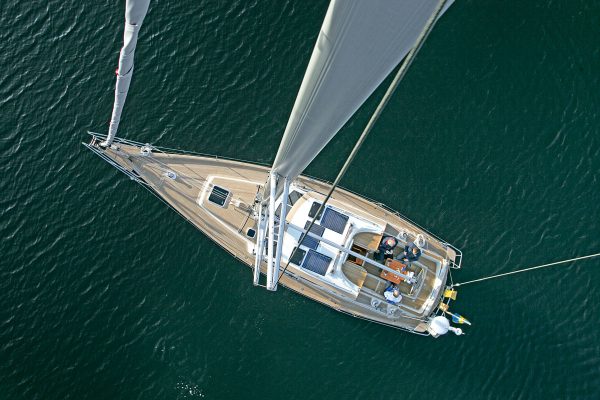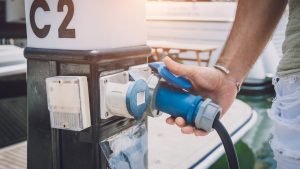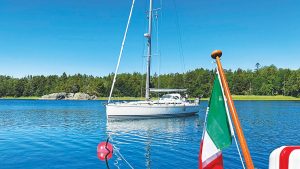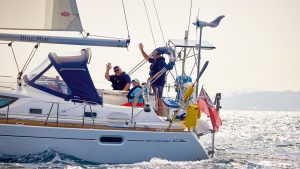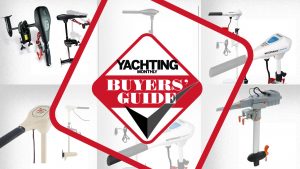What are electric yachts?
Modern electric yachts can come in all shapes and sizes. You might think that electrification of boats is limited to electric speedboats and other solely motor-powered watercraft. But you’d be wrong.
Increasingly sailing yachts are being converted to, or offered for sale with, electric systems and engines, particularly in recent years as those electric engines become more capable of propelling boats weighing several tonnes, along with the windage of their rigging, at a reasonable speed for an acceptable length of time.

The Spirit 44E under sail. Credit: Richard Langdon/Ocean Images
Since the invention of the marinised engine, fuel capacity has always been the limiting factor in covering significant distances at sea in anything other than a mega-yacht or a tanker.
That is why the best way to cover long distances on a boat fit for a small number of passengers was, and remains, wind power.
How do electric yachts work
Most sailing yachts will usually have an engine of some kind to offer propulsion when entering or leaving habour , when the wind drops, or when safe navigation demands more speed,. While some boats also carry a generator, many also use their engines to power electrical systems on board.
Small tenders used to go from ship to shore are often fitted with an outboard motor.
Recent advances in electric power have started to make electric propulsion a reasonable alternative to fossil fuel power.
Range will has always been an issue for traditional diesel engines, with the limitation of fuel being carried and, crucially, no option to top up that fuel en route. As storage of electricity in batteries is much less energy dense than diesel, range becomes even more critical for electrical propulsion.
Improvements in lithium-ion battery performance is increasing, and will likely continue to increase range every year, while improvements to solar panels, hydro-generators and wind turbines, as well as regenerative charging from the yacht’s propulsion system, all offer options to top up battery power on the go.
There have even, in recent years, been significant steps forward in creating sails with solar cells built into them in order to capture as much power from the sun as possible.
What electric yacht range can you expect?
The operating range of high-end electric propulsion system in an electric yacht of around 40ft is typically somewhere between 25 to 70 miles at 5 knots (or more, depending on the battery pack options and power generation).

Think carefully about where shade from mast, boom and rigging will fall. Credit: Graham Snook Photography
Solar panels, hydrogenerators, and wind turbines
In order to keep batteries charged, there are two options. The first is to plug in at a marina where batteries can be fully charged over the course of your stay, either for a price or included with your berthing fee.
The second option is to generate your own electricity when away from shore power, and there are various ways of keeping your electrical systems charged from renewable energy or fossil fuels when at sea.
On a 40ft yacht, a decent hydro-generator can produce around 150W of charge at around 6 knots of boat speed. Hydro-generators come in a few different forms: an outboard engine type, which you hang from the stern; a turbine towed behind the yacht on a long line; a pod type, which is fitted to the underside of a yacht’s hull; and regenerative charging, which uses the yacht’s propeller to turn the main electric motor when sailing at sufficient speeds.
All types work in the same way in that they use the yacht’s speed through the water to turn a turbine and with it a dynamo (an electric motor operating in reverse) which then supplies charge to the batteries.
Solar panel kits between 65W and 130W are ideal for live-aboard yachts and cruisers that require serious charging power for fridges and other power-hungry appliances when not underway.
Solar cells are still developing fast, so the amount of power being produced is increasing all the time, and novel ways of turning sails and whole decks into solar arrays are being developed.
Wind turbines typically claim outputs of around 400 watts or more with some claiming in excess of 600 watts. These are of particular use when at anchor and can generate a decent amount of electricity, provided there is enough wind.
Are electric yachts the future?
As with the electric car industry there is a clear push towards electric propulsion and renewable energy onboard electric yachts, the key difference being the density of water through which boats are propelled, compared to the rolling resistance of car, requiring much more energy for the same distances, even at much lower speedsHowever, the question of whether electric can fully outstrip fossil fuels in the coming years will depend on a number of factors.
Although range is much improved, the energy density of even the best batteries still has a way to go to be anywhere near equal to a yacht with a diesel engine, a large fuel tank and some jerry cans to top up. As such it does not represent the obvious choice for those looking to sail offshore over vast distances, and to date those that have tried it report needing to resort to fossil-fuel generators.
But range is now good enough for electrification to be seen by many as an option that no longer seems unsafe, particularly for those whose cruising allows them to connect to shore power on a regular basis.
There is also the question of the raw materials and heavy metals required for manufacturing large numbers of batteries, and whether these can by mined and recycled in a sustainable way.

Hydrogen is a much cleaner fluid, but may be upstaged by electric. Credit: Alamy
Hydrogen powered yachts?
Another similarity to the car industry is that there are also plenty of proponents of hydrogen as an option for greener power.
Hydrogen fuel has the potential to be entirely carbon-free, producing just water as a by-product of its use.
A decade or more ago, it was assumed that hydrogen combustion would provide a useful stepping-stone to the use of hydrogen fuel cells, because it allowed manufacturers to use existing engine blocks and design.
But in cars or boats, where every mile of extra range is critical, a key challenge with fuel cells is how to store the hydrogen.
It is a gas at normal pressure and temperature, which means that it has to be heavily compressed to get enough of it into a tank.
At sea, the current limit is 350bar, although the automotive industry has approval for 700-bar storage, which gives an extra 25% capacity.
But, to maintain such pressure, you need specialist carbon cylinders lined with impervious plastic, as well as a system of robust pumps and piping.
Across Europe, many pilot schemes are being rolled out via mobile or small-scale distributors and there are already 11 UK filling stations – concentrated in the south-east of England.
It would not take a big leap to start developing a distribution network around petrol station forecourts and extending to key harbours, although in theory at least, renewable electricity could be used to make hydrogen from water.
There are challenges, but hydrogen power should not be totally ruled out when we think about the future, even if electric yachts are where much of the key developments are taking place at the moment.





